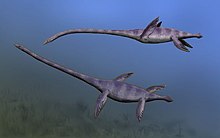Elasmosaurus
| Elasmosaurus | ||||||||||||
|---|---|---|---|---|---|---|---|---|---|---|---|---|

Elasmosaurus , skeleton reconstruction in the Canadian Museum of Nature in Ottawa |
||||||||||||
| Temporal occurrence | ||||||||||||
| Upper Cretaceous ( Campanium ) | ||||||||||||
| 83.6 to 72 million years | ||||||||||||
| Locations | ||||||||||||
|
||||||||||||
| Systematics | ||||||||||||
|
||||||||||||
| Scientific name | ||||||||||||
| Elasmosaurus | ||||||||||||
| Cope , 1869 | ||||||||||||
Elasmosaurus is a genus of plesiosaurs from the Upper Cretaceous in North America. The generic name means "platelizard"( Gr . Elasma "plate", saura = "lizard"). Of the many species described,only the type species Elasmosaurus platyurus is validsince a revision of the genus by Kenneth Carpenter . The remaining species were assigned to new genera, including Libonectes , Hydralmosaurus and Styxosaurus .
Discovery story

In 1867 the physicist Theophilus Turner found three eddies in Kansas , which he sent to Edward Drinker Cope . Turner asked Turner to retrieve the rest of the fossil , and upon examining the skeleton discovered that the fossil belonged to the plesiosaurs , but had an unusually long tail, short neck and strange vertebrae . In 1869 he published his description of Elasmosaurus platyurus in the Proceedings of the Boston Society of Natural History .
Since most plesiosaurs had long necks and short tails, he created a new taxon , the streptosauria (Gr .: streptos = upside down). Cope had misunderstood the vertebral anatomy and mounted the head on the tip of the tail. When his friend at the time, Othniel Charles Marsh, made him aware of this embarrassing error, Cope corrected his mistake and tried to buy up all the copies of the original description. This incident is often seen as the main reason for the rivalry between the two paleontologists known as the “ Bone Wars ” , which lasted until Cope's death in 1897. Today the skeleton hangs with its head on the right end in the rooms of the Academy of Natural Sciences in Philadelphia .
description
Elasmosaurus was about eleven to twelve meters long. The relatively small head, on the other hand, measured only 40 cm. The spine consisted of 72 cervical vertebrae , five vertebrae in the forelimb area, 18 dorsal vertebrae , six sacral vertebrae and about 21 caudal vertebrae . The 72 cervical vertebrae represented a record among all vertebrates until the discovery of Albertonectes . Only the sauropod dinosaur Mamenchisaurus had a longer, 13.1 meter long neck, which was supported by only 19 very long cervical vertebrae.
Of the skull only part of the snout with slender teeth and part of the occiput is known. The skull shown in many reconstructions is that of Styxosaurus . Remains of the Cretaceous pelagic bony fish, Enchodus , found between the ribs indicate that Elasmosaurus was able to catch fast-swimming prey.
Paleobiology
The Elasmosaurus hunting method is controversial . In the past, theories were put forward that Elasmosaurus would stretch its neck a few meters above seawater to look for food, such as fish. After locating these, he should have captured them by quickly re-diving. This theory was later revised, however, as the eyes of Elasmosaurus are on the top of the skull and thus do not allow any downward perspective. The position of the eyes rather suggests that the reptile ambushed its prey from below. Since the head would have been pushed to the side at high swimming speeds, Elasmosaurus could probably only swim fast with a straight neck. For this reason, Elasmosaurus probably moved slowly during the hunt and caught prey by suddenly attacking the side with its long neck; he intensified this effect by paddling his "fins". Finds show that its prey consisted primarily of fish, squid and ammonites.
literature
- Richard Ellis : Sea Dragons. Predators of the Prehistoric Oceans. University Press of Kansas, Lawrence KS 2003, ISBN 0-7006-1269-6 , p. 192.
Web links
- Ben Creisler: Dinosauria Translation and Pronunciation Guide ( Memento from October 13, 2011 in the Internet Archive )
- The tale of a tail: Or how easy it was to put the head on the wrong end of Elasmosaurus platyurus Cope 1868 - By Mike Everhart, Sternberg Museum of Natural History
- Dr. Theophilus Turner and the discovery of Elasmosaurus platyurus : The rest of the story - Von Mike Everhart, Sternberg Museum of Natural History
Individual evidence
- ↑ Steven Parker: Dinosaurs ; 2004, Weltbild publishing group; ISBN 3-8289-6031-6 ; P. 394.
- ↑ John Malam, Steven Parker: The Empire of the Dinosaurs , 2003; Scriptorium, Cologne; ISBN 1-4054-1317-4 ; Pp. 198-199
